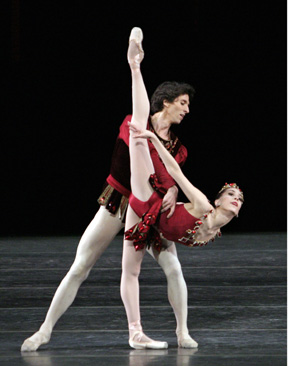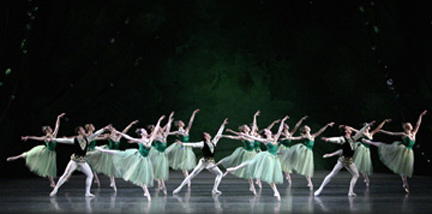Designs That Pack a Punch
Jewels
New York City Ballet
New York State Theater
New York, NY
January 31, 2004
by
Susan Reiter
copyright
2004 by Susan Reiter
 Although
it was Susan Stroman's Double Feature that was supposed to be
NYCB's nod to Broadway this season, it was when the curtain rose on Rubies,
the central portion of George Balanchine's stunning tryptich, that
a truly Broadway moment occurred: the audience applauded the scenery.
There were even a few scattered "bravo"s, and the ballet did
not begin for several seconds.
Although
it was Susan Stroman's Double Feature that was supposed to be
NYCB's nod to Broadway this season, it was when the curtain rose on Rubies,
the central portion of George Balanchine's stunning tryptich, that
a truly Broadway moment occurred: the audience applauded the scenery.
There were even a few scattered "bravo"s, and the ballet did
not begin for several seconds.
For the return of this 1967 landmark work, NYCB commissioned completely new scenery from Peter Harvey, who was responsible for its original designs. Jewels has always been a ballet with notable décor, given that the unifying theme of precious stones was carried through in the elegant and detailed costumes (by Karinska, and not altered for this revival) and the suggestion of pendants and brooches in the scenery. It had a notably rich look within the relative overall spareness of the NYCB repertory.
Robin Wagner, a noted Broadway designer, created new sets for the ballet in 1983, so my major experience of the ballet has been with those sets, aside from a viewing of the Kirov's 1999 staging, which uses Harvey's original designs, and several of the Miami City Ballet producton, with sets by Tony Walton. In all these cases, I'd always felt the scenery was natural and harmonious embellishment, making a vital contribution to the overall richness of its look without impinging on the dancers' space. The fact that the three designs were essentially variations on a theme, with the colors (enhanced by lighting) evoking the specific jewel of each section, helped make the three separate, beautifully complementary ballets into a cohesive evening.
That has now been radically changed. Harvey, at Peter Martins' invitation, has created three separate sets, all of which are considerably more busy and intrusive than either earlier design. The most egregious and disruptive, to my eye, is the robins-egg-blue environment in which "Diamonds" is now placed. The backdrop, and a receding set of side pieces that extend over the stage and meet in a kind of valence effect, surround the stage in this color, while a variation of the swirling diamond pendant from the earlier set is draped through the air.
 Aside
from the unwelcome (and illogical) specificity of evoking the sky on a
bright clear day, all this blue detracts from the gleaming white that
is the special world of "Diamonds." Similarly, the too-intensely-green
new setting for "Emeralds" seems to hint at a woodland setting,
in the softly dappled patterns on the backdrop, and even at a body of
water at its base. Worse, the ropy strands of oversized green and clear
stones that hang in arcs are much too fussy—and they suggest cheap
beads one might buy on the street. The setting resembles a garden party
with tacky decorations—and could not be more appropriate for the
reserved, mysterious formalities of "Emeralds."
Aside
from the unwelcome (and illogical) specificity of evoking the sky on a
bright clear day, all this blue detracts from the gleaming white that
is the special world of "Diamonds." Similarly, the too-intensely-green
new setting for "Emeralds" seems to hint at a woodland setting,
in the softly dappled patterns on the backdrop, and even at a body of
water at its base. Worse, the ropy strands of oversized green and clear
stones that hang in arcs are much too fussy—and they suggest cheap
beads one might buy on the street. The setting resembles a garden party
with tacky decorations—and could not be more appropriate for the
reserved, mysterious formalities of "Emeralds."
The "Rubies" setting is the most jarringly different, and also is very busy in its own way. Perhaps, in time, it will feel more appropriate to the dancing, but on first viewing the dozens of crimson vertical lines—some at the edges of the wings, some hanging freely and looking like a heavy, weighted version of streamers, and several of them having a glittery veneer—that surround the space are quite distracting. Hanging above at the center of the stage is an abstract collection of fussy shapes assembled within what looks like netting, juxtaposed with sharp diagonal lines.
Harvey's aims for his new designs, according to quotes in articles in the program and the company's newsletter, are to make Jewels more contemporary, less dated —and supposedly MORE abstract. "The new design will be cleaner, less suggestive of a particular time or place," he said. He cited the draperies that were a feature of the earlier sets as an element that made the ballet seem old-fashioned.
These three ballets summon up rich, evocative worlds through their music and dancing and costumes. The scenery is an important contribution but should—and did—enhance the cumulative effect. Now the sets are something attention-getting and overwhelming, as though the dancing itself is not to be trusted. Is this what the company feels Jewels needs to be for the 21st-century? Certainly these new designs make an impact and the audience notices them; perhaps there are those who would interpret that abrupt burst of applause as a positive sign? Presumably on repeated acquaintance they might become less jarring, but on first viewing, they place themselves in competition—even at odds—with the dancing.
As for that dancing, the cast that brought Jewels back to the repertory after a five-year absence included quite a few debuts. The ballet's touchstone ballerina roles still, after 37 years, evoke the temperamental and physical attributes of their originators, and today's interpreters need to pay homage to those powerful original presences while bringing their own imagination and musicality to the considerable challenges they pose.
The elusive, delicate subtleties of "Emeralds" go against Miranda Weese's more forthright qualities; she is a ballerina of precision and clarity, and in the Violette Verdy role she had some lovely moments but presented a studied, rather than an inspired and abandoned, performance. The Verdy solo did not have the air of private reverie that a ballerina like Stephanie Saland was able to bring to it. Jenifer Ringer, in a debut as the other ballerina (seemingly the "second" role, but she took the final bow), was more attuned to the evocative delicacy of her choreography, and her "walking" duet with James Fayette had gravitas and a touch of melancholy while avoiding the stiffness that some interpreters have brought to it. Pascale van Kipnis, in the sprightly pas de trios that interrupts the more mature, profound solos and duets with a hint of youthful optimism, danced with delicious openness and refined phrasing that make one anticipate her debut next week in the role Ringer performed.
"Rubies" united a veteran—Damian Woetzel, always charming eager and just rough enough in the swaggering, witty Villella role—with a debutante, Alexandra Ansanelli. Her role, originated by Patricia McBride, is always tricky to cast. It's usually performed by a petite ballerina, but doesn't work if (as in the case of Margaret Tracey) she is too pert and demure. Balanchine summed up so much about McBride's brilliance and individuality in this role, with dancing that is sharp and sexy, bold and witty. The particular flashing precision and the eloquent articulation of her legs and feet is hard to duplicate. Ansanelli already has some the most important qualities the role requires: the playfulness, and the ability to dance big and bold. She had fun with it, attacking it with zest and expansiveness. Somehow, though there's also an element of control, and a bit more jazzy interplay with the dynamic Stravinsky score, that could be added to what is already a fine interpretation. As the tall, leggy soloist, Teresa Reichlen was appropriately tall and leggy, exuding the hauteur of a model as she commandingly led the ensemble in the opening and losing movements. All three dancers went for broke in "Rubies" the final movement, and the ballet built to a scintillating climax.
 Maria
Kowroski, who has already been cast in many of the role Farrell created
or made her own, is the logical inheritor of the ballerina role in "Diamonds."
Making her debut on this occasion. Her sculpted line and natural affinity
for adagio made the extended pas de deux with Philip Neal, a stately prince
of a partner, beautiful, yet muted. It did not reverberate with all the
poignancy and fateful romance that can be found in the choreography that
Balanchine wedded so exquisitely to Tchaikovsky's music. To truly inhabit
this role, Kowroski's imagination needs to take wing; she is still concentrating
on the steps.
Maria
Kowroski, who has already been cast in many of the role Farrell created
or made her own, is the logical inheritor of the ballerina role in "Diamonds."
Making her debut on this occasion. Her sculpted line and natural affinity
for adagio made the extended pas de deux with Philip Neal, a stately prince
of a partner, beautiful, yet muted. It did not reverberate with all the
poignancy and fateful romance that can be found in the choreography that
Balanchine wedded so exquisitely to Tchaikovsky's music. To truly inhabit
this role, Kowroski's imagination needs to take wing; she is still concentrating
on the steps.
In his interviews, Harvey rightly refers to Jewels as timeless. And so it truly is—in its allusions to ballets of the past, its way of putting them through a bracing prism that pays homage and yet aligns them with a more contemporary approach to ballet. Balanchine created three complete, ravishing worlds, telling no stories but suggesting an infinity of possibilities through the sheer invention of his choreography, and its dialogue with the music. There was never anything dated about it, and encumbering it with new layers of busy and distracting visuals undermines what makes it timeless.
Photos, all
by Paul Kolnik:
First: Alexandra Ansanelli and Damian Woetzel in "Rubies."
Second: The ensemble in "Emeralds."
Third: Maria Kowroski and Philip Neal in "Diamonds."
Originally
published:
www.danceviewtimes.com
Volume 2, Number 6
February 9, 2004
Copyright
© 2004 by Susan Reiter
|
|